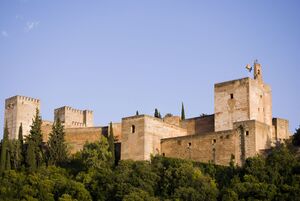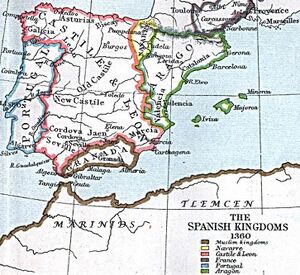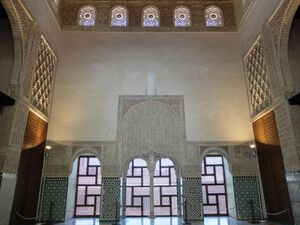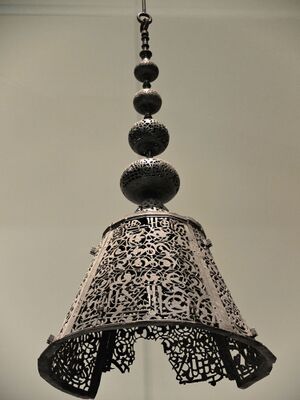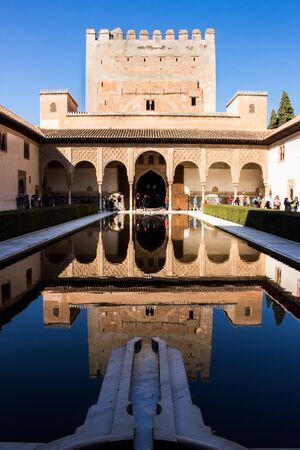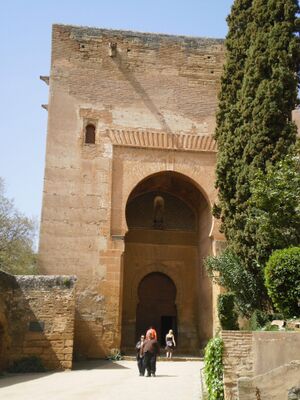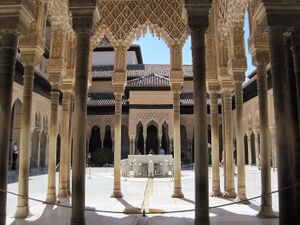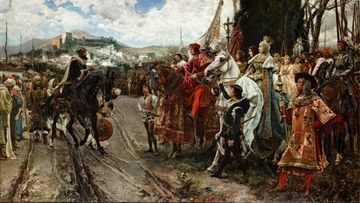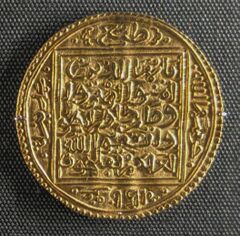مملكة غرناطة
Emirate of Granada إمارة غرناطة Imarat Gharnāṭah | |||||||||
|---|---|---|---|---|---|---|---|---|---|
| 1232–1492 | |||||||||
الشعار الحادي: Wa lā gāliba illā-llāh (العربية: ولا غالب إلا الله) | |||||||||
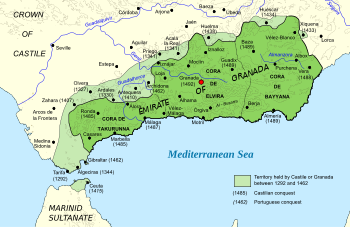 Territory of the Nasrid Kingdom from the 13th to 15th centuries | |||||||||
| الوضع | Tributary state of the Crown of Castile (intermittent) | ||||||||
| العاصمة | Granada | ||||||||
| اللغات المشتركة |
| ||||||||
| الدين |
| ||||||||
| الحكومة | Hereditary monarchy | ||||||||
| Sultan | |||||||||
• 1232–1273 | Muhammad I | ||||||||
• 1487–1492 | Muhammad XII | ||||||||
| الحقبة التاريخية | Late Middle Ages | ||||||||
• تأسست | 1232 | ||||||||
| 1492 | |||||||||
| التعداد | |||||||||
• 1314[1] | 200,000 | ||||||||
| |||||||||
| اليوم جزء من | |||||||||
|
الفتوحات 711 - 732 |
|
|
|
756 - 1039 أمويو قرطبة |
|
|
|
1039 - 1085 ملوك الطوائف |
|
1085-1145 المرابطون |
|
|
|
1147 - 1238 الموحدون |
|
|
|
1238 - 1492 مملكة غرناطة |
|
|
| مقالات ذات صلة |
مملكة غرناطة(630 - 897هـ / 1233 - 1492م) دولة تأسّست على يد ابن الأحمر سنة 1228 بعد معركة العقاب وسقوط دولة الموحدين أستمرت ممكلة غرناطة حتى عام 1492 حين سقطت بيد فرناندو الثاني.
وكان أهل غرناطة قد استدعوا ابن الاحمر بعد وفاة ابن هود سنة 635هـ ليجعلوه حاكمًا عليهم، فدخلها في رمضان سنة 635هـ، ومن يومها قامت مملكة غرناطة. بعد عدة صدامات مع الاسبان اضطر ابن الأحمر لأن يهادنهم ويؤدي الجزية لهم مثل باقي زعماء الأندلس وذلك من أجل الحفاظ على مملكة غرناطة.
Muslims had been present in the Iberian Peninsula, which they called Al-Andalus, since the early eighth century. At its greatest geographical extent, Muslim-controlled territory occupied most of the peninsula and part of present-day southern France.[2] From the ninth to the tenth century, under the Caliphate of Córdoba, the region was one of the most prosperous and advanced in Europe. Conflict with the northern Christian kingdoms was recurrent, while mounting civil strife led to a fragmenting of Muslim states in the early 11th century. This marked a precipitous decline in the power of Iberian Muslim polities and facilitated the centuries-long Christian Reconquista and the recurrent conquest of southern Spain by North African dynasties, commencing with the Almoravids in the late 11th century.
By 1230, the Almohad Caliphate in Morocco ruled the remaining Muslim territories in southern Iberia. Exploiting the Almohad's dynastic strife, the ambitious Muhammad ibn al-Ahmar rose to power and established the Nasrid dynasty in control of a sizeable portion of this territory, roughly corresponding to the modern Spanish provinces of Granada, Almería, and Málaga.[3] By 1250, the emirate was the last Muslim polity in the peninsula. Although effectively a vassal of the rising Crown of Castile, for over two centuries Granada enjoyed considerable cultural and economic prosperity. Much of the famed Alhambra palace complex was built during this period, and the Nasrids were the longest-lived Muslim dynasty in Iberia.
Nascent Christian power in Iberia meant that Granada's existence was always precarious. In 1491, after a decade of intermittent warfare known as the Granada War, the emirate was forced to capitulate to the Catholic Monarchs. The following year, Muhammad XII, the last Nasrid ruler of Granada, formally relinquished his sovereignty and surrendered his territories to Castile, eventually moving to North Africa in exile. This marked the end of independent Muslim rule in Iberia.
. . . . . . . . . . . . . . . . . . . . . . . . . . . . . . . . . . . . . . . . . . . . . . . . . . . . . . . . . . . . . . . . . . . . . . . . . . . . . . . . . . . . . . . . . . . . . . . . . . . . . . . . . . . . . . . . . . . . . . . . . . . . . . . . . . . . . . . . . . . . . . . . . . . . . . . . . . . . . . . . . . . . . . . .
التاريخ
التأسيس
أسس محمد بن نصر (حكم 1237-1273) سلالة بني نصر ، التى حكمت غرناطة ، المملكة الإسلامية الوحيدة المتبقية في شبه الجزيرة الايبيرية. في 1246 أصبح هو تابع فرناندو الثالث ملك قشتالة ووافق على دفع نصف عائدات الإمارة كجزية. عام 1257 عاد محمد وحافظ على وعده بتقاسم حصة مملكته مع بانو Ashqilula معلنا أبناءه ومحمد يوسف ورثة له. وساعد بضعة آلاف من البربر على ظهور الخيل محمد في الهجوم على قشتالة في عام 1264 عندما حدثت إنتفاضة Mudejars (المواضيع الإسلامية) في الأندلس. وغزا ألفونسو العاشر غرناطة في العام الذى تلا ، وذلك بمساعدة من ملقة Ashqilula و غواديكس. ثم في عام 1266 أعلن محمد أن ابنته لن تتزوج من Ashqilula لكن من بنو نصر ابن عمها فرج. وحاصر محمد مدينة ملقة Ashqilula وطلب من Ashqilula قشتالة أن تتحالف معه. أرسل ألفونسو العاشر منهم 1000 من الفرسان بقيادةدي لارا Nuño غونزاليس . محمد رفع الحصار وتفاوض مع ألفونسو ، وتخلي عن مزاعمه حول حلبة خيريز ، و مورسيا ووافق على دفع 2،500،000 maravedis سنويا. وتخلت قشتالة عن تحالفها مع Ashqilula الذين عادوا الى اعتبارهم كرعايا مخلصين لمحمد في غضون عام. و قد سقط محمد من فرسه وتوفي في 23 يناير 1273.
ابنه محمد الثاني حكم في الفترة بين ( 1273-1302) وقد تفاوض أيضا مع ألفونسو العاشر ، وزار بلاطه في اشبيلية. أراد ألفونسو موانئ طريفة و الجزيرة الخضراء ، وأراد محمد قشتالة لوقف دعم بنو Ashqilula . وفى عام 1275 دعا محمد قوة بحرية كبيرة بقيادة أبو يوسف لغزو اسبانيا وهزموا المسيحيين بقيادة محافظ الحدود Nuño غونزاليس دي لارا ورئيس أساقفة طليطلة. ونفذت غارات وأستولوا غلى الماشية والخيول من اشبيلية وعادوا الى المغرب بعد ستة أشهر. تكررت هذه الغارات السريعة في عام 1277 و 1282-1285. وفي مايو 1280 تعرضت غرناطة لهجوم من قبل فرسان البحر الآشكيليين Ashqilula وقشتالة. ولما ساند ألفونسو البحريين , فتحالف سانشو مع عدو محمد الحليف له عند ألفونسو الذى ساند البحريين ، . وبعد ذلك توفي ألفونسو في عام 1284 ، جمع سانشو الكثير من قشتالة وحارب فرسان البحر سنة 1285. وفي العام التالى فإن أبو يوسف ابنه ، وأبو يعقوب اصبحا قواد البحريين وعرضوا عقارات من Ashqilula في شمال أفريقيا ، وإنسحب البحريين من أوروبا. وفى عام 1288 أرسل سانشو الرابع بعثا من 300 أمير من الجنود.وفي عام 1292 ساعد غرناطة سانشو لإستعادة طريفه .وشعر محمد بالخيانة من جانب سانشو ، وحاول إستعادة طريفة مرة أخرى في 1294 ، ولكن galleys الكاتالونية ساعدت على بقاء قشتالة. ومن الفترة بين 1295-1303 ظلت غرناطة متحالفة مع أراغون واستغلت الحرب الأهلية في قشتالة. وفي سبتمبر 1301 إستعاد محمد طريفة عن طريق التفاوض في سرقسطة.
مواصلة النزاعات والضم
وعندما أصبح محمد الثالث (حكم 1302-1309) أميرا لغرناطة، فقد غير التحالفات مع قشتالة، وفي عام 1308 فإن فرناندو الرابع القشتالى وعد آراغون خايمي الثاني أن المرية وسدس غرناطة في نهاية المطاف ستؤول إليه أى لأراغون. محمد أيضا كان يعانى مشاكل مع سبتة، التي أعلنت نفسها مستقلة عن السلطان المريني (البحرى)، الذي اغتيل في 1307. وخسر محمد حلفائه، وفى عام 14 مارس 1309 حدث إنقلاب في القصر وقتل رئيس وزرائه، وقال ابن الحكيم Rundi. أن محمد استعيض عنه بمحمد نصر ولكن سمح له بالتقاعد في المنيكر. وكان الناس غاضبين من حكيم رحمه الله بسبب ثروته والمساكن الفاخرة، وبسبب سياسته الخارجية التى كانت سببا في نفور المسيحيين وشمال أفريقيا.
شكلت نصر (ص 1309-1314) تحالفا مع المرينيين في 1309. بعد أن قاد خوان مانويل أدى القشتالي 500 من الفرسان بعيدا عن معركة الجزيرة الخضراء، التى خصصها نصر إلى المرينيين. وقد خسرت غرناطة جبل طارق الذى آل إلى قشتالة في 1309 ، ولكن في العام الذى تلى تم إخضاعهم أراغون في الميريا بشدة بحيث لم يعد يرغب في مهاجمة غرناطة. وأوضح المؤرخ ابن خلدون أن نصر قد سقط بسبب ميوله نحو العنف والظلم.
عثمان بن أبي العلا, قاد المتمردين ضد نصر ، الذي تنازل عن العرش لصالح إسماعيل (حكم من 1314-1325) ولكن على عقد لغواديكس. وعندما أمر عثمان سيد كالاترافا جارسى لوبيز دي باديلا الذى حاول محاربته وهو في طريقه الى غواديكس في ربيع عام 1316 ، وحاولت قوات غرناطة منعه ، ولكن المسلمين قد هزموا وفقدوا 1540 من الرجال. ومع ذلك ، في 1319 فقد هزم المسلمين قشتالة في معركة فيغا، مما أسفر عن مقتل الأمراء خوان و بيدرو. ذهب إسماعيل على Huescar الهجومية واستعاد ، Orce ، غلرا ، ومارتوس. ووافق القشتاليون على هدنة في الأندلس لمدة ثماني سنوات. ونشرت الهدنة في 1323 عندما دمر أميرال قشتالة Jofre تينوريو أسطول غرناطة، وادعى أنه إتخذ 1،200 من الاسرى الى اشبيلية.
تمرد المدخر
Ibn al-Ahmar reigned with relative peace and stability until 1264, when the ثورة المدخر took place in Castile, lasting until 1266.[6] Mudéjar is a term used to refer to the Muslims who lived under the rule of the Christian kingdoms at this time, among whom different communities lived under different circumstances. The rebellion of 1264 was wide-ranging but it did not involve the Muslims in the old territories of Castile to the north, who lived in stable communities and were relatively well-integrated into Castilian society.[7][6] Instead, it involved the Muslim inhabitants of the Guadalquivir valley and of Castilian Andalucia, for whom the Castilian conquests of the 13th century had represented a major and still recent disruption of their communities. Some of these communities, like those of Murcia and Niebla, had been allowed to govern themselves under Castilian overlordship, while others were subjected to forced displacement and lived under harsher conditions.[7][6] It's unclear whether Ibn al-Ahmar played a role in inciting the rebellion, but he did support it.[6]
The rebellion represents the last serious attempt to reverse the Castilian conquests of the 13th century and break the Christian hold on southern Iberia.[8][9] The conditions for this must have appeared favourable at the time. Ibn al-Ahmar was enjoying good relations with the Hafsids (based in present-day Tunisia) and the Marinids (based in present-day Morocco), while the king of Castile, Alfonso X, was preoccupied with other matters. Initially, the Marinids even sent a contingent to assist the rebellion, landing at Tarifa.[9] A number of cities fell into Muslim hands, including Jerez, Utrera, Lebrija, Arcos, and Medina Sidonia.[7][10] Alfonso X also had to contend with revolts by some of the Castilian nobles.[11][10] However, his forces progressively took back control. In some cases, as in Jerez, this involved a full siege and a fresh campaign of conquest. In the end, the Muslim kingdoms of Granada and North Africa did not provide extensive assistance.[12] By 1265, the Castilians were invading the Vega (valley) of Granada and Ibn al-Ahmar was forced to renegotiate peace.[10] By the time the rebellion was over, the surviving Mudéjar inhabitants of Andalucia were mostly expelled and their towns resettled by Christians from other parts of Castile.[10][13]
النزاع مع بني أشقيلولة وتدخل المرينيين
Ibn al-Ahmar's position was further threatened by the rebellion of the Banu Ashqilula in 1266. The latter were probably alienated by his decision to establish a line of succession through his sons Muhammad and Yusuf, which would distance them from the throne.[10] They occupied Malaga and turned to Alfonso X for aid. Granada and Castile became embroiled in conflict and in each other's affairs, with Ibn al-Ahmar also supporting new Castilian rebels in 1272. The situation was not resolved by the time Ibn al-Ahmar died in 1273 and was succeeded by his son, Muhammad II (ح. 1273–1302).[10]
During Muhammad II's reign a long-term pattern of diplomacy and geopolitical competition became evident, with the Nasrids, Castilians, and Marinids each playing with or against each other at various times. Each of these dynasties was also faced by other internal and external enemies. The Nasrids thus sought to forge a path forward by making or breaking alliances according to circumstances.[15] Muhammad II also made major changes to the army of his emirate. In addition to local recruits, he recruited Zenata Berbers from North Africa, who thenceforth composed the most important element of the army and were known as the Ghazis, or Warriors of the Faith. Many were political exiles from the Marinid kingdom, including some from the Marinid family itself, and some were failed rebels against the Marinid sultan Abu Yusuf (ح. 1258–1286).[16]
Muhammad II's first preoccupation was the Banu Ashqilula, who retained Malaga and even received some recognition from Alfonso X and from Abu Yusuf.[17] He sought assistance from the Marinid sultan and offered him a base on the Iberian Peninsula. Abu Yusuf, who had recently captured Tangier and Ceuta on the southern side of the Strait of Gibraltar, thus occupied Algeciras and Tarifa in 1275, along with Ronda further inland.[18][19] While he conducted damaging raids into Christian territory, he invited both Muhammad II and the Banu Ashqilula leaders (Abu Muhammad ibn Ashqilula of Malaga and Abu Ishaq of Guadix) to join him. In 1278, the Banu Ashqilula decided to give Malaga to Abu Yusuf, who now occupied this city as well.[20][17] By now, Muhammad II felt disillusioned and saw the Marinids as a greater threat. He made an alliance with Alfonso X and incited the Zayyanids of Tlemcen, led by Yaghmurasan, to attack the Marinids. While Alfonso X blockaded Malaga by sea, Muhammad II convinced the Marinid governor of Malaga to surrender the city to him in 1279.[21][17] After a Castilian attack against Algeciras failed, however, Alfonso X made peace with the Marinids. In 1281, the Marinids, the Castilians, and the Banu Ashqilula joined forces to attack Granada.[17][22] Muhammad II's forces managed to repel the attack, thanks in large part to the effectiveness of his new Zenata troops. The deaths of Alfonso X in 1284 and of Abu Yusuf in 1286 relieved the pressure on Granada. In 1288, Muhammad II was able to finally expel the last Banu Ashqilula from Guadix, who fled to Morocco.[17]
The Marinids, now led by Abu Ya'qub, still retained Tarifa and Algeciras. In 1292, the new Castilian king, Sancho IV, made an alliance with Granada, Tlemcen, and Portugal with the intention to remove the Marinids from the Iberian Peninsula. He captured Tarifa in October 1292. Muhammad II expected the city to be returned to Nasrid control after this, but Sancho IV refused to cede it and the city thus remained under Christian control permanently.[23][24] When a Marinid attempt to retake Tarifa failed in 1294, Abu Yaq'ub decided to withdraw from the Iberian Peninsula completely and focus on his campaigns in the Maghreb instead.[25] He ceded Algeciras and Ronda to the Nasrids, thus restoring some of Granada's former territories.[26]
. . . . . . . . . . . . . . . . . . . . . . . . . . . . . . . . . . . . . . . . . . . . . . . . . . . . . . . . . . . . . . . . . . . . . . . . . . . . . . . . . . . . . . . . . . . . . . . . . . . . . . . . . . . . . . . . . . . . . . . . . . . . . . . . . . . . . . . . . . . . . . . . . . . . . . . . . . . . . . . . . . . . . . . .
هجوم بني نصر على سبتة
After Sancho IV's death in 1295, Muhammad II spent the rest of his reign going on the offensive against Castile, taking advantage of the weakness of the young new king, Ferdinand IV. He nurtured an alliance with James II of Aragon, raided Castilian territory, and recaptured two frontier forts at Alcaudete and Quesada.[28] After his death in 1302, he was succeeded by his son, Muhammad III (ح. 1302–1309), who largely continued the same policies. Eventually, when Ferdinand IV solidified his control over his kingdom in 1306, Muhammad III changed diplomatic direction by making peace with him and resuming tribute payments to Castile.[28] At the Alhambra, Muhammad III erected the Partal Palace, which is the oldest palace still standing within the complex today,[29] and commissioned the construction of the Alhambra's main mosque (no longer extant).[30]
Muhammad III then set his aims on controlling the Strait of Gibraltar. With the help of Uthman ibn Abi al-Ula, a rebel Marinid prince, he incited a rebellion against the Marinids in Ceuta and in the Gomara Mountains of Morocco.[28] In 1306[31] or 1307,[28] he captured Ceuta. He secured an alliance with Tlemcen, which was under a Marinid siege at the time, and proceeded to occupy Asilah, Larache, and Ksar es-Seghir along the Moroccan coast.[31] When the Marinid sultan Abu Ya'qub died in 1307, Uthman ibn Abi al-Ula declared himself sultan in his stead, but his bid for the throne failed as Abu Thabit, Abu Ya'qub's grandson, lifted the siege of Tlemcen and returned to retake Asilah and Ksar es-Seghir.[31] Uthman took refuge in Granada and entered into the service of the Nasrids as commander of the Ghazis, a position which his family continued to hold for much of that century.[28][31] Abu Thabit died in 1308, before he was able to retake Ceuta from the Nasrids.[31]
The Nasrid successes in the Strait of Gibraltar aroused concerns in Castile and Aragon. Ferdinand IV and James II agreed to launch a joint invasion of Granada, planning to divide the Nasrid territories between them.[32] At the same time, internal turmoil rocked the Nasrid state. A coup d'état in March 1309 forced Muhammad III to abdicate in favour of his brother, Nasr (ح. 1309–1314).[33] In the summer, Castile captured Gibraltar with the aid of Aragonese ships, Aragon laid siege to Almeria, and a rebellion returned Ceuta to Marinid control. With Ceuta no longer under Granada's hold, Nasr was able to make peace with the new Marinid sultan, Abu al-Rabi, and solicit his aid in the defense of Algeciras.[33] Both Algeciras and Almeria successfully held out until 1310, when the Aragonese retreated. After managing to capture a few frontier forts, Castile's attacks also ended with the death of Ferdinand IV in 1312.[33]
تحديات لإسماعيل الأول ومحمد الرابع
In 1312, Nasr's cousin, Isma'il, launched a rebellion with the help of Uthman ibn Abi al-Ula. In response, Nasr sought assistance from Castile, but this only made him more unpopular. In February 1314, the city opened its gates to the rebels and Nasr was forced to abdicate and retire to Guadix.[35] Isma'il I (ح. 1314–1325) became the new sultan and proved to be an effective ruler. From Guadix, Nasr caused him trouble and secured an alliance with Castile, which was then under the reign of Alfonso XI, a child overseen by two regents, Pedro and Juan.[36] Border conflicts ensued until 1319, when Castile launched a major invasion and besieged Granada. In the Battle of the Vega that followed, Granada scored one of its most decisive victories ever against the Castilians. Isma'il I went on to recover some towns, including Baeza and Martos.[36]
Isma'il I was assassinated by a cousin in July 1325 and was succeeded by his son, Muhammad IV (ح. 1325–1333), who was still a child. During this time, the emirate was shaken by more internal turmoil, due in particular to the intrigues of the Ghazis, led by Uthman ibn Abi al-Ula and his family. In 1327–8, they assassinated the vizier, Ibn Mahruq, and took effective control of the young emir.[36] Meanwhile, Alfonso XI, now grown up, was eager to establish himself as a crusader.[36] Aided by volunteers from Northern Europe, he led his army on multiple offensives against Granada, culminating in the successful siege of Teba in 1330.[37][38]
Muhammad IV reacted to the Castilian victories by seeking an alliance with the Marinids, to whom he ceded Ronda and Algeciras again in 1327 and 1328, respectively, to use as a base.[39] In 1332, he visited Fez to personally seek the intervention of the Marinid sultan, Abu al-Hasan (ح. 1331–1348), against Castile. Abu al-Hasan pledged his support and sent an army to Algeciras in 1333. It besieged Gibraltar and captured it in June.[40] By August, a Castilian counteroffensive had failed and Gibraltar remained in Muslim control thereafter until 1462.[41] On 25 August 1333, Muhammad IV was assassinated by the sons of Uthman ibn Abi al-Ula, who were opposed to his policy of close relations with the Marinids.[42][38]
الأوج
يوسف الأول ومعركة ريو سالادو
Muhammad IV was succeeded by his brother, Yusuf I (ح. 1333–1354), whose reign would mark the beginning of the Nasrid emirate's golden age.[38][43] He began by expelling the Banu'l-Ula (the family of Uthman ibn Abi al-Ula) from his realm, in revenge for the killing of his brother, and placed another Marinid family member, Yahya ibn Umar ibn Raḥḥu, in charge of the Ghazis.[38]
Alfonso XI remained a threat and the war between Castile and the Marinids and Nasrids continued, culminating in the Battle of Rio Salado in 1340. At sea, the Marinid navy, assisted by Hafsid ships, defeated the Castilian fleet, assisted by Catalan ships. On land, however, the combined forces of Castile and Portugal, along with volunteers from elsewhere in Europe, decisively defeated the Marinid and Nasrid forces at the Salado River, near Tarifa.[38][45] The Christian victory was a major milestone, allowing Castile to capture important towns on the frontier, such as Priego and Alcala la Real in 1342. Castile also captured Algeciras in 1344 after a difficult siege.[46] The siege is also notable for the first recorded use of cannons on the Iberian Peninsula, used in this case by the Muslim defenders.[47] In the long term, the Battle of Rio Salado and the capture of Algeciras put an end to North African military interventions on the Iberian Peninsula, which had been a recurring feature of the conflicts around al-Andalus since the 11th century. This was partly due also to the weakness of the Marinid state, which suffered from internal disarray in the second half of the 14th century.[47]
Spurred by his successes, Alfonso XI went on to begin a new siege of Gibraltar in 1349, but the following year he died from the Black Death that was sweeping through the region.[48] After his death, the siege ended, leaving Gibraltar under Marinid control.[49] Over the following years, Castile became too preoccupied with internal conflicts to be a serious threat to Granada and a relative peace prevailed on the frontier.[46] Despite the military defeats during his reign, Yusuf I seems to have remained trusted by his subjects and faced no serious internal challenges.[43]
عهود محمد الخامس
Yusuf I was murdered suddenly in 1354 while at prayer in the main mosque of Granada, by a civilian described as a "madman".[47] He was succeeded by his son, Muhammad V. As Muhammad V was still a minor, state affairs were managed by the hajib (chamberlain) Ridwan, the vizier Ibn al-Khatib, and the commander of the Ghazis, Yahya ibn Umar ibn Raḥḥu. Together, they maintained a policy of peace with Castile, paying tribute and providing military assistance against Castile's enemies when requested, such as against Aragon in 1359.[50]
Muhammad V's reign was interrupted by a palace coup in August 1359 that placed his half-brother, Isma'il II (ح. 1359–1360), on the throne.[51] Muhammad V escaped to Guadix, where he had support from the local garrison, but was unable to rally further support from Almeria or from Peter I, the Castilian king. He moved on and took refuge at the court of the Marinid ruler Abu Salim in Fez.[52] Isma'il II was soon assassinated in June 1360 by one of his former co-conspirators, a cousin named Abu 'Abd Allah Muhammad, who took the throne as Muhammad VI (ح. 1360–1362).[51]
While in Fez, Muhammad V was accompanied by Ibn al-Khatib, who remained loyal to him. Both men also met Ibn Khaldun, who supported their cause.[53] Eventually, Muhammad V secured the support he needed from Peter of Castile. With the support of Peter, of Uthman ibn Yahya ibn Raḥḥu (the son of Yahya ibn Umar ibn Raḥḥu), and of another figure named Ali ibn Kumasha, he returned to the Iberian Peninsula in 1362.[51] Peter and Muhammad V's forces marched on Granada, capturing various towns and the important city of Malaga. With his fortunes turning for the worse, Muhammad VI, reportedly on the advice of his allies, surrendered himself to Peter of Castile and asked for mercy. Peter executed him instead, leaving his ally Muhammad V to reclaim the throne in 1362.[54]
After his return to power, Muhammad V continued his policy of peace with Castile and remained pragmatic. Under his rule, Nasrid diplomacy was exceptionally effective, even amidst the convoluted politics of the Iberian Peninsula in this era.[55][56] The ongoing Castilian Civil War meant that Castile was not in a position to threaten Granada. Muhammad V initially supported Peter, his former ally, against his rival, Henry of Trastámara. He sent troops to help Peter, which provoked Henry's Aragonese allies into attacking Granadan ships at sea.[56] Muhammad V, in turn, used these Christian attacks to solicit materials and funds from Musa II, the Zayyanid sultan in Tlemcen.[56] When Henry captured Seville in 1366, forcing Peter to flee north, Muhammad V adapted by negotiating a new peace with him. When Peter returned to Seville in 1367, Muhammad V again renewed his loyalty to him.[56] When Peter was assassinated in 1369, leaving Castile in further chaos, Muhammad V took advantage of the situation to recapture Algeciras that year.[57] He destroyed the city and from then on its former territory became attached to Gibraltar instead.[58]
Domestically, Muhammad V eliminated the office of the shaykh al-ghuzat, the chief of the Ghazis, in 1370, placing the Zenata troops under the direct command of the Nasrid family for the first time.[51] The emirate was relatively free of internal conflict during his second reign. This period also marked the pinnacle of Nasrid culture. The vizier Ibn al-Khatib (d. 1375) was a major figure of literature, as was his successor, Ibn Zamrak (d. 1392).[60] In the Alhambra, Muhammad V undertook major construction projects, including the Palace of the Lions.[61] For the general population in the city, he sponsored the construction of a hospital (maristan), the Maristan of Granada, between 1365 and 1367.[62] His reign was also a high point of cultural exchange with the Castilian court of Peter in Seville, who built his palace in the Alcazar in the style of Granada's art and architecture.[51]
. . . . . . . . . . . . . . . . . . . . . . . . . . . . . . . . . . . . . . . . . . . . . . . . . . . . . . . . . . . . . . . . . . . . . . . . . . . . . . . . . . . . . . . . . . . . . . . . . . . . . . . . . . . . . . . . . . . . . . . . . . . . . . . . . . . . . . . . . . . . . . . . . . . . . . . . . . . . . . . . . . . . . . . .
الانحدار والسقوط
القلاقل السياسية
Muhammad V died in 1391, bringing an end to the Nasrid dynasty's golden years. Until its fall in the late 15th century, the dynasty became embroiled in succession disputes, rivalries, and assassinations. Internal conflicts often revolved around the Banu Sarraj family (known in Spanish sources as the Abencerrajes) and their rivals, who ruthlessly pursued their own interests at the expense of the emirate's stability. Externally, the emirate remained at peace during some periods thanks mainly to the fact that Castile continued to struggle with its own internal problems as well.[63]
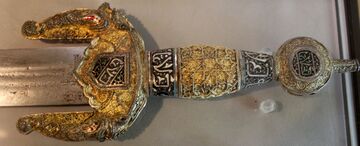
War with Castile did break out between 1405 and 1410, followed by a period of peace until 1428. External wars and internal disputes continued through the 1430s and 1440s.[65] During the early reign of Henry IV (ح. 1454–1474), Castile resumed a more ambitious crusading military policy against Granada. The emirate's position was exacerbated by violent internal confrontations with the Banu Sarraj.[66] This political chaos contributed to the final capture of Gibraltar by Castile in 1462.[67][68]
سقوط غرناطة
In the mid 15th century, Castile was preoccupied with several civil conflicts and disputes over succession. Henry IV had only one child, Isabella, who in 1468 married Ferdinand, the son of John II of Aragon. By 1479, both Henry IV and John II had died, leaving Isabella and Ferdinand as rulers of a united Castile and Aragon.[69] This was a pivotal turning point, as Granada could no longer play the two kingdoms against each other to ensure its own survival. The new royal couple, known as the Catholic Monarchs, were also united in their intention to conquer the emirate.[70]
The war against Granada offered an opportunity for Ferdinand and Isabella to harness the restless Castilian nobility against a common enemy and instill subjects with a sense of loyalty to the crown.[71] Granada's successful capture of the Castilian frontier town of Zahara in December 1481 marked the last time it was able to gain ground against Castile.[72]
The Granada War began in 1482, with Christian forces capturing Alhama de Granada in February. This was a major Christian victory, as Alhama was located in the heart of the emirate, on the road between Granada and the emirate's second city, Malaga.[73] This marked the beginning of a grinding 10-year war. The Christian force was made up of troops provided by Castilian nobles, towns, and the Santa Hermandad, as well as Swiss mercenaries.[74] The Catholic Church also encouraged other Christian countries to offer their troops and their finances to the war effort.[بحاجة لمصدر]
Meanwhile, civil war erupted in Granada as a result of succession struggles in the Nasrid ruling house, which undermined any focused resistance to the Spanish advance. In July 1482, Muhammad XII, known as Boabdil to the Christians, led a successful coup against his father, Abu'l Hasan. Abu'l Hasan, a capable military leader, was forced to flee to Malaga and the emirate was divided between him and his son.[75] Boabdil was subsequently captured by the Castilians in 1483 and was only released after making major concessions that undermined his credibility in Granada. He agreed to resettle in Guadix while his father resumed control of Granada. Abu'l Hasan died in 1485, shortly after abdicating to his brother, Muhammad ibn Sa'd (Muhammad XIII), known as al-Zaghal.[75]
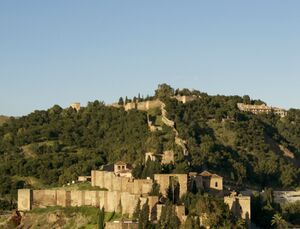
After this, the Spanish campaigns continued unabated and made slow but steady progress, while internal strife continued among the Nasrids. Boabdil returned to Granada in 1487, this time with Castilian support, and managed to force al-Zaghal to flee. Once in control, he made initial offers to surrender Granada to Ferdinand and Isabella and he even cooperated at times with the Spanish forces.[75] Meanwhile, al-Zaghal continued to lead a fierce resistance against the Spanish from outside Granada, forcing the Catholic Monarchs to deal with him first.[75] The Siege of Málaga took place from May to August 1487 and was one of the most difficult and prolonged engagements of the war.[76][77] The strongly-fortified city put up a vigorous resistance, led by one of al-Zaghal's commanders, while Boabdil continued to stand back or actively help the Catholic Monarchs. Because the city resisted, its inhabitants were given little mercy and either killed or enslaved, which encouraged other Muslim towns to surrender more quickly after this.[78] Al-Zaghal held out a while longer in Almeria, but any hope of successful resistance ended after the Spanish capture of Baeza in November 1489.[78] He negotiated the surrender of Almeria and Guadix and agreed to retire himself to the Alpujarras region, but soon afterwards he abandoned al-Andalus completely.[79] In 1489–90, he sold all his lands and moved to Oran (present-day Algeria) in North Africa.[80]
Only Granada remained under Muslim control by 1490. Boabdil and the remaining Nasrid elites negotiated with Ferdinand and Isabella, though little progress was made either way during that year.[81] By 1491, the city itself lay under siege. On 25 November 1491, the Treaty of Granada was signed, setting out the conditions for surrender. On 2 January 1492, Boabdil surrendered Granada to Ferdinand and Isabella.[82]
الأعقاب
Although some remained, the Castilians encouraged the Nasrid aristocracy to leave for North Africa, as it would likely frustrate any attempts by the Muslim population to reorganize themselves politically.[83] After the surrender of Granada, Boabdil remained for a little over a year in a country estate in the mountainous Alpujarras, as lord of es (Mondújar),[84] before leaving for Fez in North Africa.[80] According to al-Maqqari (d. 1632), he died in 1518 or in 1533 and was buried in Fez. Another account, by 16th-century writer Luis del Mármol Carvajal, claims that Boabdil died instead in battle in 1536.[85] Al-Maqqari also reports that in his time (c. 1617), Boabdil's descendants were living in poverty in Fez.[80]
About 200,000 Muslims are thought to have emigrated to North Africa after the fall of Granada.[86] It is known that many Muslims emigrated to Morocco after the departure of their emir, and some of them successively emigrated to Egypt and the Levant, settling there and contributing to its prosperity and growth.[87] For Jews as well, a period of tolerance under Muslim rule in the Iberian Peninsula came to an end with their expulsion by the Christian monarchy in 1492. The Christian conquest of Granada did not extinguish the spirit of the Reconquista. Isabella urged Christians to pursue a conquest of North Africa.[88]
Initially, under the conditions of surrender, the Muslims who remained were guaranteed their property, laws, customs, and religion. This however, did not ensue, causing the Muslims to rebel against their Christian rulers, culminating with an uprising in 1500. The rebellion was seen as a chance to formally end the Treaty of Granada, withdrawing the rights of Muslims. Muslims in the area were given the choice of expulsion or conversion. Those who remained and officially converted were thereafter known as Moriscos.
Philip II of Spain issued multiple decrees against the Morisco population, including the decree issued in 1563, which prohibited them from carrying arms, and the decree issued in 1566, which prohibited the use of the Arabic language.[89] This king believed that the most effective way to solve the problem of the Moors lay in confiscating their properties and lands and completely erasing their identity, thus ending their existence as a different community from the Catholic one. He issued a decree in the year 1567 forbidding them to wear their traditional embroidered clothes, mandating the use of Christian hats and pants, and further prohibited their language, customs and celebrations. When the Muslims tried to start a dialogue to mitigate its effects, the authorities insisted on implementing its content. In 1568, a new rebellion broke out, which lasted three years and spread to most of the areas where there was a Muslim presence. The Spanish authorities eventually succeeded in repressing it.[89]
المشاريع العثمانية والمغربية لاستعادة الأندلس
As a result of the repression of the Moriscos, some of them requested help from the Muslim sultans and princes, headed by the Ottoman sultan Bayezid II (ح. 1481–1512). One of the documents that a Christianized Andalusi wrote to the sultan requested his help and described in poor poetry the abuse of the courts of the Inquisition, calling on him to support his defeated brothers. But Bayezid was preoccupied with the disputes of the Ottoman family, so he was content to send a note of protest to the two Catholic monarchs, on which they did not act.[90]
During the 16th century, the Ottoman Empire reached the height of its power and prestige, recognized as a major power by the Holy Roman Empire and the Christian kingdoms of Western Europe. With this position of strength, Sultan Suleiman the Magnificent (ح. 1520–1566) turned his attention to the Iberian Peninsula. This coincided with the rise of Khayr al-Din Barbarossa in Algiers and the establishment of Ottoman authority over Algeria. After preparing the necessary bases for their fleets at Ifriqiya (roughly present-day Tunisia), the plan was to attack Spain itself in order to recapture Andalusia. Both Spain and Portugal were considered the main threat to the Islamic world due to the presence of their fleets in the Indian Ocean that threatened Muslim trade in the East. This attack would thus also serve to force both naval powers to fall back in order to defend themselves.[91]
Khair al-Din Barbarossa had previously begun attacking Spanish and European ships in general in retaliation for the treatment of Muslims in Andalusia. He also sent his ships to transport Muslims and Jews fleeing the Inquisition and Christianization attempts. However, Suleiman the Magnificent died in 1566 without implementing the plan against Spain. His son and successor, Selim II (ح. 1566–1574), rejected all his father's options and decided to conquer the island of Cyprus instead, believing that the Venetians should be removed from that island before he could consider the recovery of Andalusia. After the Ottomans became preoccupied on several eastern fronts and were defeated in the west at the naval Battle of Lepanto in 1571, the offensive nature of the Ottoman strategy in the Mediterranean came to an end, and with it the idea of attacking Spain and recapturing Andalusia.[92]
The other major Muslim power in the region was the Saadi Sultanate in Morocco. In 1603, the Saadi sultan Ahmad al-Mansur died and a civil war broke out between his three sons. One of them, Muhammad al-Sheikh al-Ma'mun, sought the help of Philip III to eliminate his two brothers and ascend to the throne. On the other hand, the Moriscos in Valencia and eastern Andalusia supported his brother Zidan al-Nasir, on the condition that he invaded Spain. The Spanish king took that as a motive to remove the Moriscos. The Council of State discussed this matter and presented a report recommending that the Moriscos should be expelled for religious and political reasons. The most important reason stated was the threat of invasion by the Ottomans or the Moroccans, who might try to use Granada as a toehold from which to attack the rest of the peninsula. In 1609, a decree was issued mandating the expulsion of all Moriscos, finally removing any threat they might pose.[89]
المجتمع
عمومي
Whereas in earlier centuries, particularly under the rule of Umayyad Cordoba, the population of al-Andalus had been a relatively pluralistic mix of Muslims, Christians, and Jews of different ethnic backgrounds, the Emirate of Granada that formed in the 13th century was much more homogenously Muslim.[93] Arabic was by far the dominant language and Romance languages were no longer in significant usage.[94]
The kingdom was densely-populated, its population increased in part thanks to the arrival of large numbers of Muslim refugees from the territories newly conquered by the Christian kingdoms to the north.[95] This influx of refugees from the Christian north continued intermittently up to the 15th century.[96] Estimates of the population are only tentative, but the population of the entire emirate may have been around 300,000[97] and the population of Granada itself around 50,000.[95]
المسلمون
The Muslim population of al-Andalus had diverse origins, including Iberians (known as Muladíes in Spanish or Muwallad in Arabic) and North African Berbers. By the 13th century, however, the established population had largely assimilated to Arab culture and to a common "Andalusi" identity.[98] The fortress mentality of Granada's Muslims, however, made it difficult for the many Muslims who continued to live under Christian rule in Castile and Aragon – referred to as Mudéjars in Spanish and by modern historians – to maintain strong cultural links with the Arabic culture of Granada. As a result, the Muslims under Christian rule became culturally distinct from those living under Nasrid rule during this period.[99]
While the Berber substratum of the traditional Andalusi population had largely been assimilated by the 13th century, new groups began to arrive from North Africa in the late 13th century that retained a more distinct identity.[100] Most important among these were Zanata families from the Banu Marin (Marinid) tribe, which included those who were recruited to serve the Nasrid army. Most of them immigrated between 1275 and 1350. Given their military role, the Nasrids settled them intentionally in strategic cities such as Algeciras, Gibraltar, Ronda, and Málaga.[100] Some non-Zanata Berber groups are also attested, particularly the Ghumara, after whom the Gomeres district in present-day Granada (on the south slope of the Alhambra hill) is named.[101]
اليهود
The only non-Muslim population of any significance within the emirate were Jews, who were generally concentrated in certain cities.[93] Among them were long-established families who had lived here for generations as well as recent arrivals from the Christian north. Of the latter, some had fled during the Christian advance in the 13th century, fearing the political change, while others fled later during persecutions under Christian rule, particularly after the pogroms of 1391.[102] The largest community was in Granada, although it is not clearly known in what part of the city they lived. There were other communities throughout the emirate, notably in Guadix and in Málaga.[103] The Jewish population within the emirate has been estimated at around 3000. In 1492, 110 Jewish households were counted in Granada.[97] Jews were prominent in professions such as merchants, interpreters or translators, and as doctors/physicians.[103]
Jews were granted a protected status (dhimmi) that gave them legal rights to their religion and a certain legal autonomy for their community. The community had a leader, known as the Nagīd, who collected taxes and acted as its representative to the Nasrid rulers.[97] Historical sources report that Jews were required to wear an external sign or mark (shārāt) in public that identified them as Jewish. Ibn al-Khatib reports that this rule was introduced during the reign of Isma'il I (ح. 1314–1325). Al-Maqqari (d. 1632), citing an earlier source, reports that they were required to wear a yellow cap and a type of sash in the 13th century. More regulations and restrictions appear to have been added over time, though it's likely that they were not consistently enforced in some cases.[104] Muhammad V seems to have been particularly welcoming towards Jews: 300 families returned with him to Granada when he raided Jaén in 1367, while towards the end of his reign many others arrived after the persecutions of 1391 in the Christian north.[103]
المسيحيون
The native Mozarabic Christian population of al-Andalus had largely disappeared prior to the Nasrid period due to pressures of assimilation, persecution, and expulsion under Almoravid and Almohad rule. Many had fled north to the Christian kingdoms or were expelled to North Africa where they could not cause trouble. The Christian population within the Nasrid emirate was thus very small and largely transitory, consisting of visitors, merchants, political exiles, and prisoners of war.[93][105] They did not have the protected status of dhimmi that Jews and the former Mozarabic Christians had, but were instead granted safe conduct (aman) through special and often temporary agreements with varying conditions.[106] Merchants were the most important group, hailing from other parts of the Iberian Peninsula but also, especially, from Italian trading cities such as Genoa. They resided in major cities that gave them access to both the coast and the kingdom's interior, such as Málaga, Granada, and Almería.[107]
Christian prisoners were another major group and their conditions varied depending on their social background: captured nobles and royalty were treated with respect and given comfortable houses to live in, while captured commoners were confined to prisons in the large cities, including the dungeons in the Alhambra.[108] Some of these captives were freed after converting to Islam, often joining the Nasrid army or the sultan's personal guard. Some of them even achieved high positions in the Nasrid court. The mothers of both Yusuf I and Muhammad V had been captured Christian women.[109]
الاقتصاد
The emirate's economy was mostly agricultural. The rural population of the countryside was organized primarily into traditional alquerías (small farming communities). These were usually occupied by free peasants who owned the land and cultivated it mostly for subsistence.[110] Larger farming estates, which could be owned by the Nasrid family members or other members ruling class, were typically found on the edge of urban centers.[111] Cultivation was intensive, diversified, and usually required sophisticated irrigation strategies, which in turn required well-organized management at a collective or community level, reflecting already-established traditions in al-Andalus.[112] Dry farming was also known and was more common in the emirate's frontier areas, where animal husbandry was also a common activity.[113] In some coastal areas, agriculture was specialized in a different manner to allow for commerce and export, encouraged by the presence of nearby port cities and their merchants.[114]
As the Strait of Gibraltar became more open to commercial ships towards the end of the 13th century, maritime navigation around the Iberian Peninsula became cheaper and faster, accelerating the development of trade networks between the Mediterranean (particularly Italy and the regions of Catalonia and Provence) and northern Europe. Granada benefited from its location near the Strait.[115]
Partly due to the heavy tributary payments to Castile, Granada's economy specialized in the trade of high-value goods.[3] Integrated within the European mercantile network, the ports of the kingdom fostered intense trading relations with the Genoese, but also with the Catalans, and to a lesser extent, with the Venetians, the Florentines, and the Portuguese.[116] Despite its small size, the emirate's superior agricultural technology and favorable climate allowed it to produce and export goods to the rest of Europe that had formerly been only accessible in the eastern Mediterranean, particularly sugar, silk, and dried fruits.[117][95] Manufactured goods like luxury ceramics were another important export.[118] Granada and its ports were also useful commercial centers from which to gain access to North African markets.[115]
European Mediterranean merchants were quick to exploit these opportunities and established relations with the emirate.[118] Granada's economy was heavily financed by Genoese bankers who also aimed to gain control of the gold trade carried in through the trans-Saharan trade routes.[119] However, after Portugal opened direct trade routes to sub-Saharan Africa by sea in the 15th century, Granada became less important as a regional commercial center.[بحاجة لمصدر]
الثقافة
| تاريخ الدول العربية |
|---|
Despite its frontier position, Granada was also an important Islamic intellectual and cultural center, especially in the time of Muhammad V, with figures such as Ibn Khaldun and Ibn al-Khatib serving in the Nasrid court.[60] Ibn Battuta, a famous traveller and historian, visited the Emirate of Granada in 1350. In his journal, he called Granada the "metropolis of Andalusia and the bride of its cities."[120] The Nasrid sultans and members of the court were active patrons of literature, the arts, or sciences, and in many cases they were writers or scholars themselves.[121]
الأدب
The most highly valued form of literature among Granada's elites was poetry, which was collected in anthologies and even used as architectural decoration in the Alhambra palaces.[122] Other important forms included mirrors for princes-type works, historical chronicles (akhbār or tā'rīkh), works on Sufism, travel chronicles (riḥla), and works of rhyming prose that narrated stories or anecdotes (maqāmāt). Many of these genres overlapped with each other; for example, historiography could be written in rhymed prose or could include poems.[123]
Abu al-Tayyib al-Rundi (d. 1285–6), whom some contemporaries considered the last great writer of al-Andalus, served under Muhammad I and Muhammad II. He wrote both poetry and prose, including educational treatises intended for the sultan or his family.[124] Ibn al-Khatib was a polymath and poet of the Nasrid court in the 14th century. He authored many works in various fields, and his poetry is carved into the walls of the Alhambra palace.[125] Ibn Zamrak, his successor as vizier, was also one of the major poets of the emirate's history. His poems are likewise found carved in many parts of the Alhambra, including the Court of the Lions.[60]
العمارة
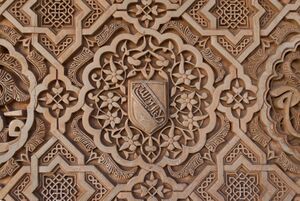
The architecture of Nasrid Granada embraced extensive surface decoration in wood, stucco, and zillij tiling, as well as making use of elaborate muqarnas sculpting in many buildings. The Nasrids' most famous architectural legacy is the Alhambra, a hilltop palace district protected by heavy fortifications and containing some of the most famous and best-preserved palaces of western Islamic architecture, including what is known today as the Comares Palace and the Court of the Lions. The palace complex was developed throughout the period but some of the most important contributions were generally made during the rule of Yusuf I and Muhammad V during the 14th century.[126][127]
The summer palace and gardens known as the Generalife were also created nearby. This reflected a tradition of royal countryside estates dating back to the Almoravids and continued under their successors – as exemplified by the older Agdal Gardens of Marrakesh and Buhayra Gardens of Seville, both from the Almohad era.[128]
Other notable buildings and structures from this era are the Madrasa al-Yusufiyya (now known as the Palacio de la Madraza), the Funduq al-Jadida (now known as the Corral del Carbón), parts of Granada's city walls, the Alcázar Genil, and the Cuarto Real de Santo Domingo in Granada, in addition to various other fortifications and smaller monuments across the former emirate's territory.[129][127]
الموسيقى
Gharnati music (الطرب الغرناطي) is a variety of Andalusi music that originated in Granada and moved to North Africa where it survived to this day.[130]
العلوم
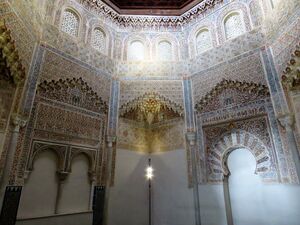
Due to the migrations (both forced or voluntary) of people across the region, Granada was able to attract scholars of various sciences. Mathematics, astronomy, agronomy, and botany were among the subjects studied by some individuals, but the most prominent scientific field in Granada was medicine.[132]
Muḥammad ibn Aḥmad al-Riquṭi al-Mursi, a scholar from Murcia, was invited to Granada by Muhammad II after Murcia was conquered by Alfonso X in the 1260s. He was installed in the countryside outside the city, where he founded a school that taught mainly medicine and, to a lesser extent, other disciplines. It did so independently from the teaching that occurred in mosques.[133] Although the school did not last throughout the Nasrid period, it was an important instrument in training other disciples and helped to attract other intellectuals to the emirate.[133]
In 1349, Yusuf I founded Granada's first madrasa, a type of institution that was already present in North Africa and the rest of the Muslim world.[134] The Madrasa al-Yusufiyya, named after him, taught traditional disciplines such as Islamic law and Arabic grammar, but it also taught medicine, like al-Riquti's school. It attained significant prestige and attracted students from both al-Andalus and North Africa.[134]
العسكر
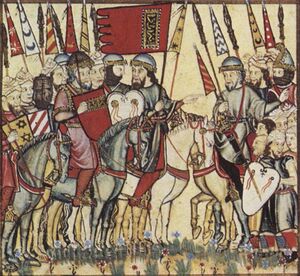
Constantly under threat by both the Christian kingdoms to the north and the Muslim Marinid Sultanate to the south, the population of the Emirate of Granada developed a "siege mentality".[136] The country consequently maintained a strong military. Its border territories were dotted with castles maintained by frontier warriors (thagri) led by armoured elite warriors who were influenced by and comparable to the Christian knights. However, the core of the emirate's army consisted of highly mobile light cavalry as well as light infantry.[136]
The Granadan army was ethnically and culturally mixed. A large part were recruited locally through the jund system in which families with military obligations were registered and conscripted for service. In addition, the Granadan rulers encouraged North African warriors to migrate to the country and serve as ghazi. These immigrants were mostly Zenata (or Zanata) Berbers and eventually organized as Volunteers of the Faith, a factually autonomous and very powerful unit within the Granadan military.[136] The Zenata served as light cavalry, which gave rise to the Spanish term jinete (derived from the name 'Zenata'), which denoted this type of light cavalry.[137][138] They formed the backbone of the Granadan army, serving both in crucial battles as well as in regular raids inside Christian territory.[139][137] They were highly mobile on the field, armed with lances, javelins, and small round shields known for their flexibility, and used their own characteristic set of tactics.[137][140][141] They sometimes also served as auxiliaries in Castilian armies, sent by the Nasrid emirs of Granada to aid their allies.[137] They were recruited and led by exiled members of the Marinid family and settled within the kingdom of Granada. Their Marinid commander was known as the shaykh al-ghuzāt ('chief of the ghazis'), but in 1374 Muhammad V suppressed this office due to their political interference, after which they were commanded by a Nasrid or Andalusi general.[137]
Muhammad V reduced the status of the Volunteers and reformed the military, strengthening instead the Andalusian components of the Granadan military. The smallest part of the regular Granadan military were Christians and ex-Christians who had been hired by the emirs or defected to them. These were often Spanish knights and termed Mamluks; these warriors were organized as elite bodyguards by some emirs. To augment their army, the Granadans also hired foreign mercenaries.[136]
In regard to its organization, the Granadan military was formally headed by the emir and divided into several units. The frontier areas were possibly commanded by rais, while each important frontier garrison was led by a shaykh khassa. The army was divided into major divisions, each led by a wali, under whom military emirs served as leaders for 5,000 troops, followed by qaid leading 1,000, naqib leading 200, and finally nazir leading eight. The Volunteers of the Faith were initially commanded by the shaykh al-ghuzat. In addition, there existed a Gendarmerie-like shurta in Granada city, commanded by the sahib al-shurta.[136] The Granadan army was usually accompanied by a corps of guides (dalil), religious figures who tended to morale, armourers, medics, and some poets as well as orators.[142]
قائمة سلاطين غرناطة
The following is a list of Nasrid rulers, alongside the years that they reigned. Some years overlap due to competition for the throne between two or more Nasrid claimants.
انظر أيضاً
- بنو نصر
- غزل ابن عمار
- Nasrid–Ottoman relations
- Border of Granada
- Romance of Abenamar
- List of Sunni Muslim dynasties
ملاحظات
المراجع
- ^ O'Callaghan, Joseph F. (1983). A History of Medieval Spain. Cornell University Press. p. 460. ISBN 978-0-8014-9264-8. Archived from the original on 4 أكتوبر 2021. Retrieved 6 ديسمبر 2020.
At the Council of Vienne in 1314, Aragonese envoys informed the pope that there were 200,000 people in the Kingdom of Granada, though it is not known on what that figure was based.
- ^ Fernando Luis Corral (2009). "The Christian Frontier against al-Andalus (Muslim Spain): concept and politics during the reigns of King Fernando I of Castile and Leon and his successors until 1230". In Natalie Fryde; Dirk Reitz (eds.). Walls, Ramparts, and Lines of Demarcation: Selected Studies from Antiquity to Modern Times. LIT Verlag Münster. p. 67. ISBN 978-3-8258-9478-8.
- ^ أ ب García-Arenal, Mercedes (2014). "Granada". In Fleet, Kate; Krämer, Gudrun; Matringe, Denis; Nawas, John; Rowson, Everett (eds.). Encyclopaedia of Islam, Three. Brill. ISSN 1873-9830.
- ^ Irwin 2004, p. 25.
- ^ Cabanelas Rodríguez 1992, p. 129.
- ^ أ ب ت ث Kennedy 1996, p. 278.
- ^ أ ب ت Harvey 1990, pp. 51–54.
- ^ Harvey 1990, pp. 52–53.
- ^ أ ب Kennedy 1996, pp. 278–279.
- ^ أ ب ت ث ج ح Kennedy 1996, p. 279.
- ^ Harvey 1990, p. 53.
- ^ Harvey 1990, pp. 53–54.
- ^ Harvey 1990, p. 54.
- ^ Arnold 2017, pp. 242–244.
- ^ Kennedy 1996, pp. 280–281.
- ^ Kennedy 1996, p. 283.
- ^ أ ب ت ث ج Kennedy 1996, p. 284.
- ^ O'Callaghan 2011, pp. 63–65, 70.
- ^ Albarran, Javier (30 أبريل 2018). "Granada". In Fitz, Francisco García; Monteiro, João Gouveia (eds.). War in the Iberian Peninsula, 700–1600 (in الإنجليزية). Routledge. ISBN 978-1-351-77886-2.
- ^ O'Callaghan 2011, pp. 65–74.
- ^ O'Callaghan 2011, pp. 75–76.
- ^ O'Callaghan 2011, p. 78.
- ^ O'Callaghan 2011, pp. 98–102.
- ^ Kennedy 1996, pp. 284–285.
- ^ Abun-Nasr 1987, p. 109.
- ^ O'Callaghan 2011, p. 113.
- ^ Dodds 1992, p. 276.
- ^ أ ب ت ث ج Kennedy 1996, p. 285.
- ^ "The Partal". Patronato de la Alhambra y Generalife (in الإنجليزية الأمريكية). Archived from the original on 29 يناير 2022. Retrieved 28 نوفمبر 2020.
- ^ Arnold 2017, p. 236.
- ^ أ ب ت ث ج O'Callaghan 2011, p. 121.
- ^ Kennedy 1996, pp. 285–286.
- ^ أ ب ت Kennedy 1996, p. 286.
- ^ Arnold 2017, pp. 236-238, 261.
- ^ Kennedy 1996, pp. 286–287.
- ^ أ ب ت ث Kennedy 1996, p. 287.
- ^ O'Callaghan 2011, pp. 154–159.
- ^ أ ب ت ث ج Kennedy 1996, p. 288.
- ^ O'Callaghan 2011, p. 152.
- ^ O'Callaghan 2011, pp. 162–163.
- ^ O'Callaghan 2011, pp. 163–165.
- ^ O'Callaghan 2011, p. 165.
- ^ أ ب Harvey 1990, p. 190.
- ^ Bloom 2020, pp. 152–155.
- ^ O'Callaghan 2011, pp. 166–188.
- ^ أ ب Kennedy 1996, pp. 288–289.
- ^ أ ب ت Kennedy 1996, p. 289.
- ^ O'Callaghan 2011, pp. 213–216.
- ^ O'Callaghan 2011, p. 217.
- ^ Kennedy 1996, pp. 289–290.
- ^ أ ب ت ث ج Kennedy 1996, p. 290.
- ^ Harvey 1990, p. 210.
- ^ Mahdi, Muhsin (2015). Ibn Khaldûn's Philosophy of History: A Study in the Philosophic Foundation of the Science of Culture (in الإنجليزية). Routledge. p. 40. ISBN 978-1-317-36635-5.
- ^ Harvey 1990, pp. 211–214.
- ^ Harvey 1990, pp. 214–218.
- ^ أ ب ت ث Kennedy 1996, pp. 291–292.
- ^ Harvey 1990, p. 215.
- ^ قالب:Encyclopaedia of Islam, Second Edition
- ^ Dickie 1992, p. 142.
- ^ أ ب ت Kennedy 1996, p. 291.
- ^ Arnold 2017, pp. 236, 265, 269, 273.
- ^ "Maristan of Granada/ Foundation Stone/ Fountain heads in the shape of lions". Qantara-med.org. Retrieved 27 يوليو 2023.
- ^ Kennedy 1996, pp. 292–295.
- ^ Dodds 1992, p. 285.
- ^ Kennedy 1996, pp. 293–297.
- ^ Kennedy 1996, pp. 298–299.
- ^ O'Callaghan 2014, p. 109.
- ^ Kennedy 1996, p. 299.
- ^ Catlos 2018, p. 377.
- ^ Harvey 1990, p. 268.
- ^ Barton 2004, p. 103.
- ^ Barton 2004, p. 103; Kennedy 1996, p. 300.
- ^ Kennedy 1996, p. 300.
- ^ Barton 2004, p. 104.
- ^ أ ب ت ث Kennedy 1996, pp. 301–303.
- ^ O'Callaghan 2014, p. 159.
- ^ Harvey 1990, pp. 294–300.
- ^ أ ب Kennedy 1996, p. 303.
- ^ Catlos 2018, p. 389.
- ^ أ ب ت Latham, J.D.; Fernández-Puertas, A. (1993). "Naṣrids". In Bosworth, C. E.; van Donzel, E.; Heinrichs, W. P.; Pellat, Ch. (eds.). The Encyclopaedia of Islam, New Edition, Volume VII: Mif–Naz. Leiden: E. J. Brill. pp. 1020–1029. ISBN 90-04-09419-9.
{{cite encyclopedia}}: Invalid|ref=harv(help) - ^ Harvey 1990, pp. 307–308.
- ^ Harvey 1990, pp. 308–323.
- ^ Harvey 1990, p. 328.
- ^ خطأ استشهاد: وسم
<ref>غير صحيح؛ لا نص تم توفيره للمراجع المسماة:822 - ^ Harvey 1990, pp. 327–328.
- ^ Barton, Simon (2009). A History of Spain (in الإنجليزية). Bloomsbury Publishing. p. 104. ISBN 978-1-137-01347-7.
- ^ Hallaq, Hassan (AH 1431 – AD 2010). Beiruti Families Encyclopedia: The Historical Roots of Beiruti Families of Arab, Lebanese, and Ottoman Origin (First Edition). Beirut – Lebanon: House of the Arab Renaissance. C. part one. s. 32.
- ^ Barton 2004, p. 105.
- ^ أ ب ت "تاريخ المسلمين في الأندلس – أ.د. محمد سهيل طقوش : مكتبة فلسطين للكتب المصورة : Free Download, Borrow, and Streaming : Internet Archive". web.archive.org. 10 سبتمبر 2020. Archived from the original on 10 سبتمبر 2020. Retrieved 16 يونيو 2023.
- ^ الخليج, دار (17 نوفمبر 2019). مشاهدات وانطباعات من الشرق والغرب – عبد الوهاب العمراني, دار الخليج. دار الخليج للنشر والتوزيع / daralkhalij for Publishing and Distribution. ISBN 9789957519247. Retrieved 16 يونيو 2023 – via Google Books.
- ^ Ember, Collins; Al-Haris, Abd al-Latif (verified 1999). Example and legitimacy issues in early Ottoman history. Ijtihad Journal. The House of Ijtihad. Forty-third number: 121.
- ^ نيقولاي إيفانوف. الفتح العثماني للأقطار العربية 1516–1574 (in Arabic).
{{cite book}}: CS1 maint: unrecognized language (link) - ^ أ ب ت Harvey 1990, p. 14.
- ^ Harvey 1990, pp. 14–15.
- ^ أ ب ت Kennedy 1996, p. 277.
- ^ Sarr 2020, p. 180.
- ^ أ ب ت Sarr 2020, p. 182.
- ^ Sarr 2020, pp. 177–180.
- ^ Harvey 1990, p. 15.
- ^ أ ب Sarr 2020, pp. 180–181.
- ^ Sarr 2020, p. 181.
- ^ Sarr 2020, pp. 179–180, 182–183.
- ^ أ ب ت Sarr 2020, p. 183.
- ^ Sarr 2020, pp. 182–183.
- ^ Sarr 2020, pp. 184–185.
- ^ Sarr 2020, p. 185.
- ^ Sarr 2020, p. 188.
- ^ Sarr 2020, p. 186.
- ^ Sarr 2020, pp. 186–188.
- ^ Fábregas 2021, p. 156.
- ^ Fábregas 2021, p. 157.
- ^ Fábregas 2021, pp. 157–158.
- ^ Fábregas 2021, pp. 158–159.
- ^ Fábregas 2021, p. 161.
- ^ أ ب Fábregas 2021, p. 163.
- ^ Fábregas García, Adela (2006). "La integración del reino nazarí de Granada en el espacio comercial europeo (siglos XIII–XV)". Investigaciones de Historia Económica (in الإسبانية). 2 (6): 16–17. doi:10.1016/S1698-6989(06)70266-1.
- ^ Fábregas 2021, pp. 163–164, 169.
- ^ أ ب Fábregas 2021, p. 164.
- ^ Arrighi, Giovanni (2010). The Long Twentieth Century: Money, Power, and the Origins of Our Times (in الإنجليزية). Verso. p. 118. ISBN 978-1-84467-304-9.
- ^ "On to al-Andalus and Morocco: 1349–1350 | ORIAS". orias.berkeley.edu (in الإنجليزية). Retrieved 27 أبريل 2018.
- ^ Catlos 2018, pp. 358–359.
- ^ Puerta Vílchez 2020, p. 393.
- ^ Puerta Vílchez 2020, p. 393 and after.
- ^ Puerta Vílchez 2020, pp. 399–400.
- ^ "Travelers of Al-Andalus, Part VI: The Double Lives of Ibn al-Khatib – AramcoWorld". www.aramcoworld.com. Archived from the original on 25 يوليو 2020. Retrieved 16 مارس 2020.
- ^ Bloom 2020, pp. 151–153.
- ^ أ ب Barrucand, Marianne; Bednorz, Achim (1992). Moorish architecture in Andalusia (in الإنجليزية). Taschen. pp. 183–215. ISBN 3822876348.
- ^ Arnold 2017, pp. 181, 197, 211, 227, 251–252236-238, 261.
- ^ Bloom 2020, pp. 167–171.
- ^ مؤلفين, مجموعة; السياسات, المركز العربي للأبحاث ودراسة (1 يناير 2015). التاريخ الشفوي (المجلد الثاني): مقاربات في الحقل الاجتماعي – الأنثروبولوجي. المركز العربي للأبحاث ودراسة السياسات. ISBN 978-614-445-023-9. Archived from the original on 23 يونيو 2022. Retrieved 26 يونيو 2020.
- ^ Bloom, Jonathan M.; Blair, Sheila S., eds. (2009). "Granada". The Grove Encyclopedia of Islamic Art and Architecture (in الإنجليزية). Vol. 2. Oxford University Press. pp. 120–127. ISBN 978-0-19-530991-1.
- ^ García Sánchez 2020, pp. 419–432.
- ^ أ ب García Sánchez 2020, pp. 415–417.
- ^ أ ب García Sánchez 2020, pp. 417–418.
- ^ O'Callaghan 2011, p. 42.
- ^ أ ب ت ث ج Nicolle & McBride 2001, p. 38.
- ^ أ ب ت ث ج Kennedy 1996, pp. 282–283.
- ^ Fletcher, Richard (1992). Moorish Spain (in الإنجليزية). University of California Press. p. 159. ISBN 978-0-520-24840-3. Archived from the original on 23 مارس 2022. Retrieved 23 مارس 2022.
- ^ Harvey 1990, p. 230.
- ^ Echevarria, Ana (2009). Knights on the Frontier: The Moorish Guard of the Kings of Castile (1410–1467). Brill. pp. 99, 114. ISBN 978-90-47-42441-3.
- ^ O'Callaghan 2011, p. 226.
- ^ Nicolle & McBride 2001, p. 39.
المصادر
-
{{cite book}}: Empty citation (help) -
{{cite book}}: Empty citation (help) -
{{cite book}}: Empty citation (help) -
{{cite book}}: Empty citation (help) -
{{cite book}}: Empty citation (help) -
{{cite book}}: Empty citation (help) -
{{cite book}}: Empty citation (help)
وصلات خارجية
- (بالإسپانية) Al-Ándalus III: el Sultanato De Granada (1232-1492) y Una Breve Reseña Sobre la Alhambra
- (بالإسپانية) R.H. Shamsuddín Elía, Historia de Al-Andalus, Boletín N° 53 -08/2006 Al-Ándalus III: El Sultanato De Granada (1232-1492)
- (بالإسپانية) Nicolás Homar Vives, Genealogy of the Nasrid Kingdom of Granada
- (بالفرنسية) Genealogy of the muslim dynasties in Spain
- (بالعربية) بنو نصر/النصريون/بنو الأحمر في غرناطة Les Nasrides, Les Banû al-Ahmar à Grenade
- CS1 الإنجليزية الأمريكية-language sources (en-us)
- CS1 الإسبانية-language sources (es)
- Short description is different from Wikidata
- Missing redirects
- Use dmy dates from October 2023
- Articles containing explicitly cited عربية-language text
- Pages using infobox country or infobox former country with the flag caption or type parameters
- Articles with hatnote templates targeting a nonexistent page
- Articles containing إسپانية-language text
- Articles with unsourced statements from July 2023
- CS1 errors: empty citation
- Emirate of Granada
- Former countries on the Iberian Peninsula
- Former Islamic monarchies in Europe
- Former Arab states
- History of Andalusia
- 1238 establishments in Europe
- 1492 disestablishments in Europe
- 1492 disestablishments in Spain
- بلدان سابقة
- States and territories established in 1238
- States and territories disestablished in 1492
- تاريخ إسپانيا




